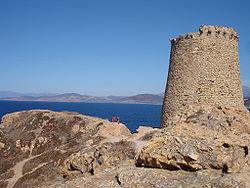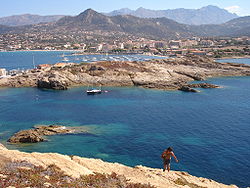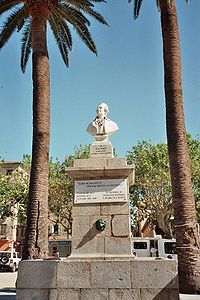
L'Île-Rousse
Encyclopedia



Communes of France
The commune is the lowest level of administrative division in the French Republic. French communes are roughly equivalent to incorporated municipalities or villages in the United States or Gemeinden in Germany...
in the Haute-Corse
Haute-Corse
Haute-Corse is a French department. It constitutes the northern part of the island of Corsica.- History :The department was formed on 15 September 1975, when the department of Corse was divided into Haute-Corse and Corse-du-Sud...
department of France
France
The French Republic , The French Republic , The French Republic , (commonly known as France , is a unitary semi-presidential republic in Western Europe with several overseas territories and islands located on other continents and in the Indian, Pacific, and Atlantic oceans. Metropolitan France...
on the island of Corsica
Corsica
Corsica is an island in the Mediterranean Sea. It is located west of Italy, southeast of the French mainland, and north of the island of Sardinia....
.
It was founded in 1758 by Pasquale Paoli
Pasquale Paoli
Filippo Antonio Pasquale di Paoli , was a Corsican patriot and leader, the president of the Executive Council of the General Diet of the People of Corsica...
to create a port that would not be in the hands of the Genoese
Republic of Genoa
The Most Serene Republic of Genoa |Ligurian]]: Repúbrica de Zêna) was an independent state from 1005 to 1797 in Liguria on the northwestern Italian coast, as well as Corsica from 1347 to 1768, and numerous other territories throughout the Mediterranean....
like Calvi. Italian
Italian language
Italian is a Romance language spoken mainly in Europe: Italy, Switzerland, San Marino, Vatican City, by minorities in Malta, Monaco, Croatia, Slovenia, France, Libya, Eritrea, and Somalia, and by immigrant communities in the Americas and Australia...
being still the administrative language of Corsica (until 1848), the town was originally called Isola Rossa (Red Island, from the ochre colour of a rocky islet that served as a natural harbour).
With Saint-Florent
Saint-Florent, Haute-Corse
Saint-Florent is a commune in Haute-Corse department of France on the island of Corsica. It is a fishing port located on the gulf of the same name....
, it is one of only two communes in the département to have a French name — all the others have kept their Italian names despite the repeated demands of Corsican nationalists.
History
Inhabited since very ancient times (3 - 5 000 years BC), l'Île-Rousse was 1 000 BC a small, prosperous town dependent on Tyre in PhoeniciaPhoenicia
Phoenicia , was an ancient civilization in Canaan which covered most of the western, coastal part of the Fertile Crescent. Several major Phoenician cities were built on the coastline of the Mediterranean. It was an enterprising maritime trading culture that spread across the Mediterranean from 1550...
, called Agilla. Destroyed by the Phoenician fleet of Calaris (Galeria
Galeria
Galeria is the name of a Roman gens, or family. Male members of the gens Galeria bore the nomen Galerius, female members Galeria.Galeria may refer to the following persons:* Galeria , a Roman actress during the 1st century BC....
), Agilla came under Roman rule as Rubico Rocega (red rock) until the 4th century. Being so close to the sea, it was threatened by pirates and other potential enemies, and was not inhabited for several centuries except for fishermen and peasants who lived on the products of the sea and earth around the villages of Santa Reparata and Monticello
Monticello
Monticello is a National Historic Landmark just outside Charlottesville, Virginia, United States. It was the estate of Thomas Jefferson, the principal author of the United States Declaration of Independence, third President of the United States, and founder of the University of Virginia; it is...
.
In the 17th century, merchants from Santa Reparata established shops to trade by sea with the coastal villages of the Balagne, Nebbio, and the west of the Cap Corse
Cap Corse
Cap Corse, a geographical area of Corsica , is a 25-mile long peninsula located at the northern tip of the island. At the base of it is the second largest city in Corsica, Bastia...
. About 1759, Pascal Paoli, who often came to Balagne, decided to equip Corsica with a port in the north west of the island to try to cut the sea traffic between Genoa
Genoa
Genoa |Ligurian]] Zena ; Latin and, archaically, English Genua) is a city and an important seaport in northern Italy, the capital of the Province of Genoa and of the region of Liguria....
and Calvi. His plans prepared, he persuaded the Balagne government, sitting in Algajola
Algajola
Algajola is a commune in the Haute-Corse department of France on the island of Corsica.-Population:-References:*...
, to authorise him to create a fort protecting the port (the Scalu) on 10 December 1765. L’Île-Rousse was born from this decision.
Description
Built on a bay bounded to the north west by the rocky islets of red porphyryPorphyry (geology)
Porphyry is a variety of igneous rock consisting of large-grained crystals, such as feldspar or quartz, dispersed in a fine-grained feldspathic matrix or groundmass. The larger crystals are called phenocrysts...
which give it its name, and to the south by an immaculate white sand beach, l’Île-Rousse is presented to the tourist in all its beauty, extending westwards from the sea to the hill of the Sémaphore and the col de Fogata.
The old town of Pascal Paoli, le Père de la Patrie (the Father of the Fatherland), is made up of paved streets, almost rectilinear and oriented north-south. From the quays of the commercial port installed on 3 of the 6 small islands, the fishing port and the bridges which link the harbour complex to the coast and the market with its twenty one columns, the fortifications and the houses of the old city grew over the years, from 1765 into the first half of the 19th century.
Certain houses with their interior Florentine staircases are remarkable. The first church built in 1740 and destroyed in 1936 gave its name to the rue Notre-Dame. The church dedicated to Notre Dame de Miséricorde is next to an old Franciscan
Franciscan
Most Franciscans are members of Roman Catholic religious orders founded by Saint Francis of Assisi. Besides Roman Catholic communities, there are also Old Catholic, Anglican, Lutheran, ecumenical and Non-denominational Franciscan communities....
convent, while the parish church of l’Île-Rousse, the Immaculée Conception de Marie
Immaculate Conception
The Immaculate Conception of Mary is a dogma of the Roman Catholic Church, according to which the Virgin Mary was conceived without any stain of original sin. It is one of the four dogmata in Roman Catholic Mariology...
, is on the west of the main square, with its enormous date palms
Date Palm
The date palm is a palm in the genus Phoenix, cultivated for its edible sweet fruit. Although its place of origin is unknown because of long cultivation, it probably originated from lands around the Persian Gulf. It is a medium-sized plant, 15–25 m tall, growing singly or forming a clump with...
(planted 1890) in the shade of which it is good to play a game of petanque
Pétanque
Pétanque is a form of boules where the goal is, while standing inside a starting circle with both feet on the ground, to throw hollow metal balls as close as possible to a small wooden ball called a cochonnet or jack. It is also sometimes called a bouchon or le petit...
.
The new town blends harmoniously with the old at the place Paoli, shaded by hundred year old plane trees
Platanus
Platanus is a small genus of trees native to the Northern Hemisphere. They are the sole living members of the family Platanaceae....
, where it is good to take the summer air. The old town offers visitors the chance to stroll on the old paving stones, partly restored, along streets with historic names: Pascal Paoli, Napoleon, les freres Arena (Arena brothers), Luois Philippe, Agilla..
Built by Pascal Paoli, equipped by its municipal officials, after 1815 with a blazon
Blazon
In heraldry and heraldic vexillology, a blazon is a formal description of a coat of arms, flag or similar emblem, from which the reader can reconstruct the appropriate image...
decorated with the royal lily of France
Fleur-de-lis
The fleur-de-lis or fleur-de-lys is a stylized lily or iris that is used as a decorative design or symbol. It may be "at one and the same time, political, dynastic, artistic, emblematic, and symbolic", especially in heraldry...
and run for than a half-century by elected Bonapartist
Bonapartist
In French political history, Bonapartism has two meanings. In a strict sense, this term refers to people who aimed to restore the French Empire under the House of Bonaparte, the Corsican family of Napoleon Bonaparte and his nephew Louis...
officials, l’Île-Rousse is a town with a share in the history of Corsica. Its contradictions make it an attractive and unexpected place for the tourists who come each year to sit down under the plane trees of its beautiful central square.
Population
External links
In French:

